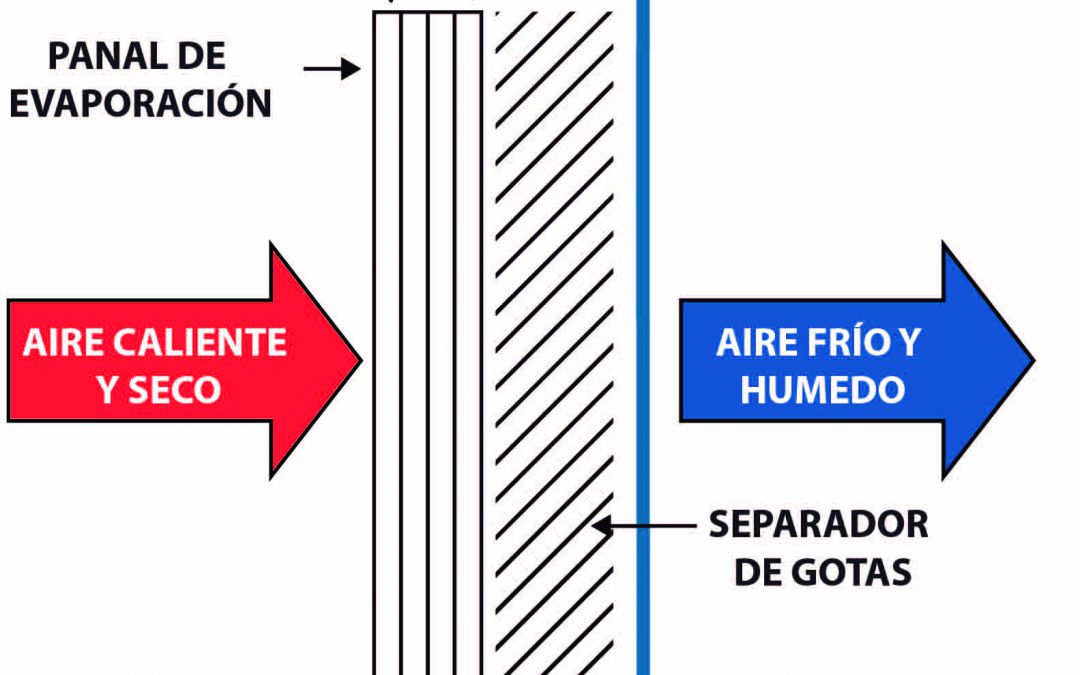Given your interest we transcribe here the article published in the following link:
https://www.andira.org.mx/2017/02/03/enfriamiento-evaporativo/
Evaporative cooling
Considered the first air conditioning technology used by man, evaporative cooling allows maximum use of resources and reduce hearing pollution.
The principle of evaporative cooling saves more than 95% of the water that recirculates
Evaporative cooling equipment are installations that put an air stream in contact with another water stream to lower the air temperature and take advantage of the energy absorbed by the water in its evaporation process.
This principle of cooling is based on evaporation, where the equipment produces a cloud of water droplets, either by spraying or by free fall, which is put in contact with a current of air.
The principle of evaporative cooling is used mainly in cooling towers or condensers, where the surface evaporation of a small part of the water induced by contact with the air results in the cooling of the rest of the water. With this phenomenon two effects are achieved, cooling the air and humidifying it.
In air conditioning and refrigeration installations, energy efficiency and electric power consumption are directly related to the condensing temperature of the refrigerant used, so the choice of cooling system directly influences investment costs, life cycle, energy efficiency of the installation and environmental impact.
Advantage
- Compact design: thanks to its higher performance, evaporative cooling equipment is more compact than conventional cooling
- Low maintenance cost
- Low refrigerant loads
- Collaborate with energy efficiency
- Minimum space required for installation: cooling towers or evaporative condensers can also be installed inside buildings
- Low sound level: cooling towers and evaporative condensers are intrinsically quieter than air cooled equipment, since they require less air flow and, therefore, fewer fans or that are smaller in size. In addition, as they reach lower cooling temperatures, the associated cooling plant can be smaller and quieter
- Simple installation
- Better energy balance: the decrease of 1 ° C in the condensation temperature represents a 3% saving in electricity in the refrigeration sector
- Lower installed electrical power
- Lower peak demand
- Lower initial investment
- Lower cost of the electrical installation
- Less occupied space
- Lower floor area
- More respectful with the environment: by reducing the use of electrical energy
- Less need to produce electricity: “dry” or air-cooled systems are less efficient than “wet” or evaporative cooling systems, which means less electricity consumption with this type of equipment
- Lower CO2 emission: the generation of electric power contributes significantly in the emission of gases that destroy the ozone layer, which cause the greenhouse effect
- Minimum water consumption: many processes still use water for cooling; Thermal pollution and the waste of this expensive resource can be avoided by using the systems that recirculate the cooling water. The principle of evaporative cooling saves more than 95% of recirculated water, while providing other important environmental benefits
The Association of Cold Companies and their Technologies estimates that replacing the evaporative towers and condensers of the air conditioning installations (in Spain) would mean increasing the generation capacity needed to approximately 3 thousand megawatts, which would be equivalent to building three new nuclear power plants.
Did you know?
Evaporative conditioning was the first form of air conditioning used by humans. It is known that ancient Greek and Roman civilizations used moist straw bundles placed in the windows to lower the temperature of the rooms. The Arabs learned from the Persians how to use the sources to lower the temperature of shaded patios, which in turn are part of the classical architecture of southern Spain. From 1920, with the beginning of the use of electrical energy, soaked fans and sheets were used to reduce the air temperature of the rooms in desert areas of Arizona. These concepts have now been refined, resulting in evaporative air conditioning equipment.
Source: Ministerio de Sanidad de España
Control y Ventilacion, S.L. is a company of international renown within the industrial and livestock sector, for being a manufacturer of products within the evaporative cooling sector, such as the HUMIBAT, evaporative plastic cooler; or its NUCLEOS towers, Cooling Towers. In both products, the substrate in which the evaporative process is produced is a plastic honeycomb, a honeycomb resistant both to physical and chemical attacks, and at the same time flexible, a honeycomb with a mesh structure, made of polyethylene High Density, and marketed under the names of PANAL C & V or in the case of being a drop separator, SEPARADOR C & V .
For more information you can see the following links:
www.controlyventilacion.com/refrigeracion-evaporativa/
www.controlyventilacion.com/relleno-y-separador/
www.controlyventilacion.com/torres-de-refrigeracion/


Recent Comments